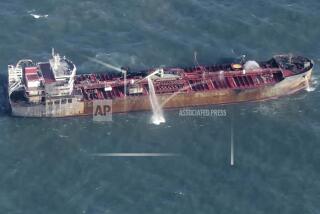25 Freighter Sinkings in 2 1/2 Years Called Scandal
- Share via
SYDNEY, Australia — The bulk carrier Singa Sea pitched oddly in the heavy waves and alarms went off. Second officer Sabas Martus, working in his cabin, slipped into a life jacket and headed for his boat station.
Within minutes, the 574-foot ship split in two and disappeared. Martus was hurled free when the stern section rolled over.
A lifeboat popped to the surface and he and seven other crewmen clambered aboard. One died and the others drifted for 29 days in the Indian Ocean before being rescued.
The sinking in 1988 of the 26,586-ton freighter, registered in the Philippines, is one of the few recent losses of big bulk carriers in which survivors lived to tell the tale. Martus testified at an Australian hearing into the loss of the Singa Sea.
Twenty-five huge ships like the Singa Sea, each weighing up to 200,000 tons, have sunk around the world since January, 1990, because of structural failure, according to figures compiled by the Australian government. Only six were lost in 1989.
Although the losses have caused an outcry in the shipping community, there has been little public attention because the ships went down in remote areas with few crew members aboard. Many of the losses went unreported by news media.
“It’s an international scandal,” Bob Collins, the Australian transport and communications minister, said.
Collins, supported by maritime unions and marine safety experts, claims that unscrupulous shipowners, incompetent ship surveyors, indifferent cargo shippers, inexperienced crews and lax international enforcement of regulations contributed to the sinkings and deaths of seamen.
“If you had a situation in aviation of losing 747s at the same rate, they’d ground every bloody aircraft in the world,” he said.
Peter Morris, head of a Parliament committee investigating the rash of ship losses, said they had cost the lives of 480 sailors in four years.
Several ships have disappeared without a trace, not even an SOS radio message. They are thought to have broken up, capsized or gone down bow-first like submarines.
The loss without a trace of two ships that loaded ore in western Australia prompted the House of Representatives inquiry into ship safety. The committee is expected to report by November.
Intercargo, which represents owners of more 1,000 bulk ships, presented papers to the committee concluding that the main causes of the sinkings were age--the average age of ships lost was 19 years--and poor crewing, loading methods, inspections and maintenance.
Experts generally agree that:
* The depressed international economy is forcing owners to operate ships longer.
* Crews are increasingly recruited in low-wage, Third World countries where training is poor.
* Use of lightweight high-tensile steel that is thinner than traditional steel is probably a factor. High-tensile steel is more likely to crack and suffer dangerous stresses than traditional steel.
* Owner demands that port time be cut to save costs has led to loading rates that may overstress the hull. Ore is poured into holds at up to 13,000 tons an hour, causing ships to bend in the middle. Hull plates and frames are damaged by bulldozers, mechanical grabs and jackhammers used to unload cargo.
The role of classification societies has been questioned.
Such “class societies” are supposed to ensure that ships are properly designed and built and to inspect vessels periodically for safety. Without the certificates they provide, ships have difficulty getting insurance or entering most major ports.
“Not only are these societies unaccountable, but with each successive lost bulker, it could be argued that their personnel are either incompetent or corrupt or simply out of touch with the operating environment of these ships,” Paul Slater, chairman of First International Finance Corp., a U.S. shipping-finance company, said at a seminar on bulk-carrier losses.
In a paper presented to the Australian committee, he said: “Ship operations are neither examined nor certified by any responsible body and, worse still, the officers’ certificates are issued by flag states who rarely if ever test the competence or experience of the particular officer.
“Some ships are driven every day by incompetent officers, and no one cares.”
Australian authorities also criticize some of the world’s 46 classification societies, claiming that some approve ships that should never put to sea. The Maritime Safety Agency inspects 25% of the 2,600 ships that call at Australian ports each year and says 60% have deficiencies despite holding valid survey certificates.
Major classification societies have reacted to the sinkings with new standards for building and inspections.
“We have done a great deal to pinpoint the problems,” said Eila Henderson of Lloyd’s Register, one of the most respected classification societies.
Actions have included more frequent inspections, new structural specifications to strengthen the ships and discussions of ways to measure hull stress and design voyage-data recorders that could float free of ships that sink.
Lloyd’s Register, founded in London in 1760, is listed in Britain as a charity with a charter to set technical standards for safety at sea and on land.
Other classification societies have government backing.
James Bell, permanent secretary of the International Assn. of Classification Societies, which represents 11 major societies, said much had been done to improve bulk-carrier design, maintenance and construction.
He added, however, that the minimum maintenance characteristic of the early 1980s was “pretty disastrous.”
The association also is considering setting up a database to serve as an early warning system. Each instance of damage to a ship recorded by a member society would go into the database.
More to Read
Sign up for Essential California
The most important California stories and recommendations in your inbox every morning.
You may occasionally receive promotional content from the Los Angeles Times.












